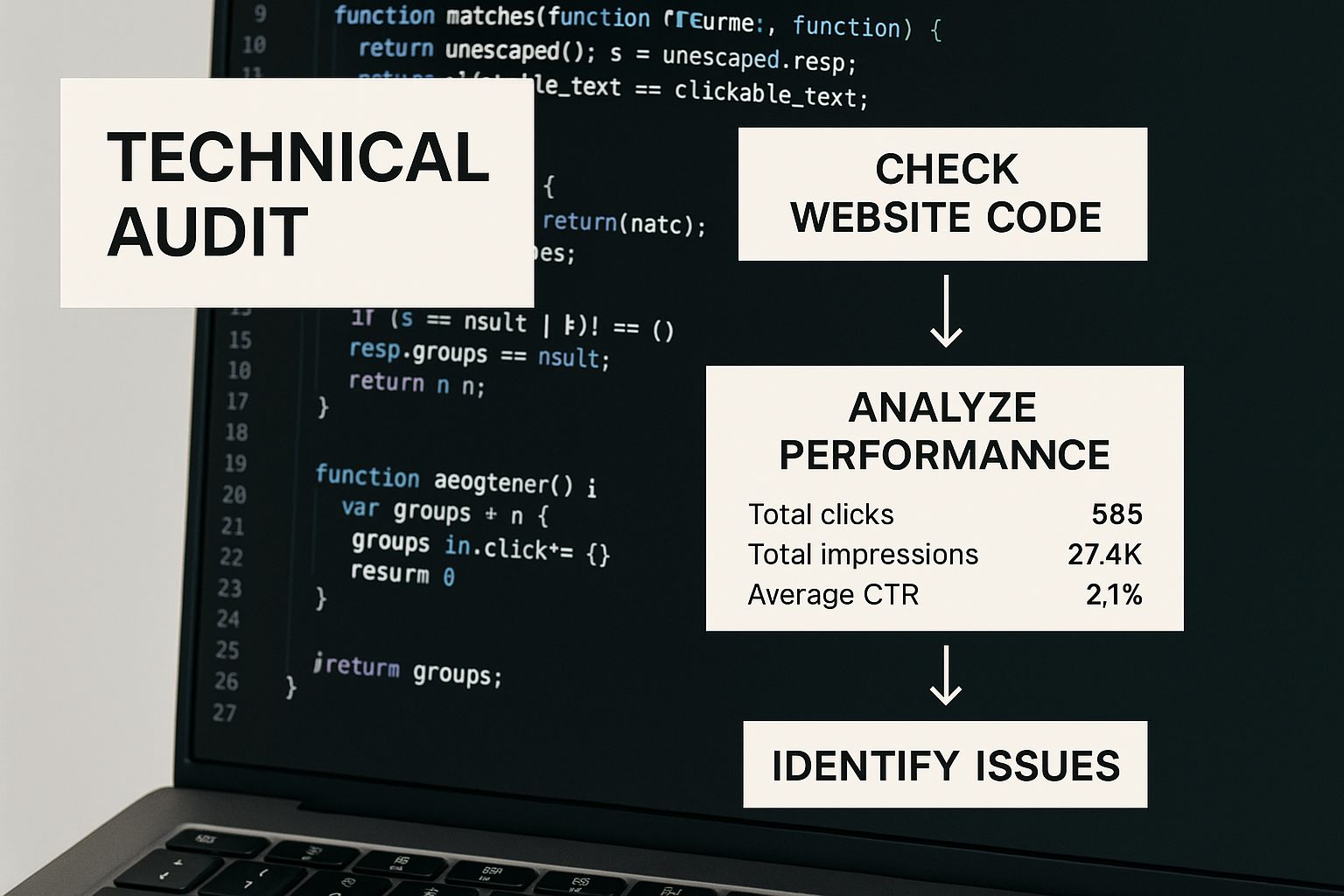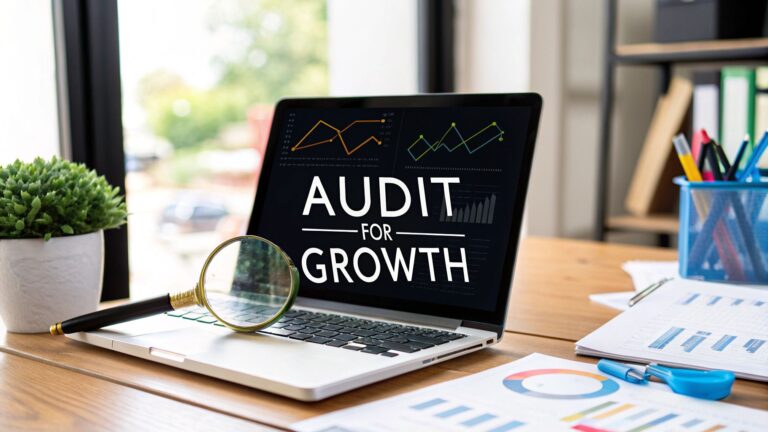Learning how to do a website audit is less about following a rigid checklist and more about systematically examining your site’s health to find real growth opportunities. It’s a process of using tools like Google Search Console to find technical hiccups and then stepping back to assess everything from page speed to how a customer actually buys something.
The end goal is always the same: a clear, prioritized action plan that will actually improve performance. For example, an audit might reveal that your most popular blog post has a slow load time and a weak call-to-action. Fixing just those two things could double its lead generation potential.
What a Modern Website Audit Truly Involves
Let’s get one thing straight: a modern website audit is not just a simple error check. It's a strategic deep dive into your site's overall health—think of it as a complete physical for your most important digital asset. It’s not a chore you have to get through; it’s a proactive strategy to boost your visibility, protect your brand, and, most importantly, create a better experience for your users.
This process goes far beyond just spotting a few broken links. It’s about piecing together the complete picture of your website’s performance and understanding how every single component—from a line of code to a blog post—supports your business goals. A successful audit gives you a clear roadmap for what to fix, what to improve, and where to focus your resources for the biggest impact.
The Four Pillars of a Comprehensive Website Audit
A truly effective audit stands on four essential pillars. Each one covers a different, critical aspect of your site's performance. When you look at them together, you get a full, 360-degree view of its health.
Too many people make the mistake of focusing on just one of these areas, like technical SEO, while completely ignoring the others. For instance, I recently audited a site that was technically flawless but had a 90% bounce rate on its services page. The reason? The content was full of jargon, and the "Request a Quote" button was buried at the very bottom. You have to look at the whole picture.
Here's a breakdown of the four pillars that form the foundation of any worthwhile audit. Focusing on these ensures you cover all your bases, from the back-end code to the front-end user journey.
The Four Pillars of a Comprehensive Website Audit
| Audit Pillar | Primary Goal | Key Areas to Check |
|---|---|---|
| Technical SEO | Ensure search engines can crawl, index, and understand your site. | Site architecture, indexability, sitemaps, robots.txt, schema markup, mobile-friendliness. |
| Performance & Security | Optimize for speed, stability, and protection against threats. | Page load speed, Core Web Vitals, HTTPS implementation, server response time, malware scans. |
| On-Page SEO & Content | Evaluate content quality, relevance, and keyword effectiveness. | Keyword targeting, content gaps, title tags, meta descriptions, internal linking, image optimization. |
| UX & Conversions | Analyze the user journey and identify barriers to conversion. | Navigation clarity, call-to-action effectiveness, conversion funnels, accessibility, mobile usability. |
By addressing all four pillars, you're not just fixing problems—you're building a stronger, more resilient digital presence that serves both search engines and your customers.
A comprehensive evaluation is key to ensuring your site performs optimally across functionality, usability, security, and search visibility. Increasingly, these audits also place a strong emphasis on accessibility, making sure businesses comply with standards like the Web Content Accessibility Guidelines (WCAG) to create inclusive experiences.
You can learn more about how these practices are shaping digital strategies by exploring the evolving trends in website audits.
Fixing Your Technical SEO Foundation
Your technical SEO is the structural integrity of your website. If it’s weak, every other marketing effort you make could come crumbling down. Think of it like the plumbing and wiring of a house—if it's faulty, it doesn't matter how great the furniture looks. This part of your website audit is about getting your hands dirty and making sure search engines can find, crawl, and rank your content without hitting any roadblocks.
This isn't just a surface-level scan. A proper technical audit means digging deep into your site’s health by examining crawl errors, indexation status, sitemap functionality, and mobile usability. For example, a recent audit for a client revealed their entire blog was unintentionally blocked by a single line in their robots.txt file, making years of content invisible to Google. Finding that one line was a game-changer.
This infographic breaks down the core process of a technical audit, from the initial crawl all the way to the final fixes.

As you can see, a technical audit is a cycle of discovery and resolution. It’s all about analyzing the code and metrics that define your site's health and making targeted improvements.
Checking Your Site's Indexation Status
First things first: you need to find out which of your pages Google actually knows about. If a page isn't indexed, it simply doesn't exist in the search results. You can get a quick, powerful overview using the "Pages" report inside Google Search Console.
Dive into the "Not indexed" tab. You’ll likely see a few common reasons:
- "Discovered – currently not indexed": Google knows the page exists but hasn't crawled it yet. A practical insight: if you see important pages here, it's a sign your internal linking strategy is weak and you need to link to them from more prominent pages.
- "Crawled – currently not indexed": Google has visited the page but decided it wasn't valuable enough to index. This often means the content is too thin. For example, a 150-word service page with no unique information is a prime candidate for this status.
- "Page with redirect": This isn't automatically an error, but you need to confirm that these redirects are intentional and pointing to the right final destination.
Finding a crucial service page sitting in the "not indexed" section is a major red flag. It means no one can find that service through Google, which is a massive problem for any business.
Hunting Down and Fixing Broken Links and Sitemaps
Broken links are silent authority killers. Your technical audit must uncover them, especially when you consider that a staggering 66% of backlinks on websites are broken, leaking valuable authority. A broken or outdated sitemap is just as bad—it’s like giving a search engine a faulty map and hoping it finds your most important pages.
A common mistake I see is business owners creating a sitemap once and then completely forgetting about it. Your sitemap should be dynamic, automatically updating whenever you add a new page or post. A practical tip is to check if your SEO plugin (like Yoast or Rank Math) is set to auto-update the sitemap. This ensures Google always has your site's most current blueprint.
A thorough technical audit will also expose other fundamental gaps. For instance, 7.4% of top-ranking pages are missing title tags, and a shocking 23% of websites still don't use structured data. According to the latest SEO findings on Exploding Topics, these are low-hanging fruit—missed opportunities that a good audit can easily spot and fix.
Let’s imagine a real-world scenario. Your "About Us" page links to team member profiles, but several of those employees have left and their pages were deleted, resulting in 404 errors. An audit tool like Screaming Frog (which has a free version for up to 500 URLs) will flag these instantly. Fixing them is as simple as removing the dead links or redirecting them to a relevant page, which immediately plugs a leak in your site's authority.
Auditing Your Site for Speed and Security

Let’s be blunt: a slow or vulnerable website isn't just an annoyance—it's a direct threat to your credibility and your bottom line. Speed and security aren't optional extras. They are fundamental to user trust and a core part of any effective website audit.
A single bad experience, whether it's a page that takes forever to load or a "Not Secure" warning from a browser, can send potential customers running to your competitors for good. This is why we dedicate a specific part of the audit to these two critical pillars.
Mastering Your Need for Speed
Website performance isn't just about how fast your homepage loads. It's about how quickly a user can actually interact with your content and feel that the experience is seamless. This is where tools like Google's PageSpeed Insights become invaluable, giving you a clear score and a detailed diagnostic report.
When you run a test, zero in on the Core Web Vitals. These are the metrics Google uses to measure real-world user experience:
- Largest Contentful Paint (LCP): This measures how long it takes for the biggest visual element—like a hero image—to appear. A practical insight: I often see LCP issues caused by a massive, high-resolution image file that was uploaded directly from a camera. Simply compressing that image can shave seconds off the load time.
- Cumulative Layout Shift (CLS): Ever tried to click a button, only for the page to jump and make you click something else entirely? That frustrating experience is layout shift. A low CLS score means your page is visually stable. A common culprit is an ad or banner that loads late and pushes content down.
So, what are the usual suspects for poor performance? Huge, uncompressed images are a classic culprit. I’ve seen e-commerce stores with gorgeous, high-resolution product photos that haven't been optimized, and it just cripples their page speed, leading to terrible LCP scores and frustrated buyers.
Another frequent offender is render-blocking JavaScript. This is code that forces the browser to pause and wait before it can display the rest of the page. A huge win can be deferring non-critical scripts so they load after the main content is already visible. You should also explore how to leverage browser caching to speed up your website, which dramatically reduces load times for repeat visitors.
Fortifying Your Digital Defenses
Beyond speed, a thorough audit must scrutinize your website's security to protect it from vulnerabilities. Security and uptime are non-negotiable; data shows the average website faces about 94 attacks daily. That sheer volume alone should tell you why this isn't something to take lightly.
The fallout from a security breach is severe. With over 12.8 million websites infected with malware globally and downtime costing businesses upwards of $300,000 per hour, proactive security checks are an investment, not an expense. You can find more website statistics on DiviFlash.
Start with the basics. Is your SSL certificate active and correctly configured? A practical tip: go to your site and check if it automatically redirects from "http://" to "https://". If it doesn't, you need to set up that redirect to ensure all visitors have a secure connection.
Next, make sure your platform—whether it's WordPress, Shopify, or something custom—and all of its plugins or apps are fully updated. Outdated software is one of the most common backdoors for attackers. For more specific guidance, you can find excellent resources on how to secure your WordPress site.
Finally, run a comprehensive malware scan. Many hosting providers offer this service, but you can also use external tools to check for malicious code that could compromise your site and, more importantly, your customers' data. Tackling these security points is a critical step in a truly comprehensive website audit.
Improving Your On-Page SEO and Content
Once your site’s technical foundation is solid, it's time to shift your focus to what your visitors actually see and read: your on-page elements and content. This is where the audit moves beyond code and servers to dig into whether your pages are truly connecting with both search engines and human beings.
Think of this phase as a deep-dive into every piece of content. You're scrutinizing each page, blog post, and product description to make sure it serves a clear purpose and nails user intent. For example, a common finding is that a product page lists features but fails to explain the benefits. A simple content tweak to focus on "what this does for you" can dramatically improve conversions.
Identifying and Fixing Content Issues
One of the most common—and damaging—issues I see is content cannibalization. This is what happens when you have multiple pages on your site fighting for the same keyword. It confuses search engines and splits your ranking power. For instance, if you have three separate blog posts all trying to rank for "small business marketing tips," Google has no idea which one is the definitive source.
To fix this, you have to consolidate. Here’s a practical way to handle it:
- Merge: Cherry-pick the best information from the competing pages and combine them into one authoritative "super-post."
- Redirect: Set up 301 redirects from the old, weaker pages to your new, comprehensive one.
This sends a clear signal to Google, telling it exactly which page to prioritize. You’re consolidating your authority instead of diluting it. Another critical task is hunting down and refreshing outdated content to ensure it’s still accurate, relevant, and valuable to your audience.
A crucial part of any real website audit is evaluating if your content genuinely solves a problem. It’s not enough to just sprinkle in keywords; your articles and guides must answer the user’s underlying question better than anyone else on the web. A practical insight: search for your target keyword and read the top 3 results. Does your content answer the question more thoroughly and clearly? If not, you know what you need to improve.
This requires a mental shift from asking "what keywords should I use?" to "what does my audience truly need to know?" When your content provides real solutions, the rankings often take care of themselves.
Performing a Content Gap Analysis
To really pull ahead of the pack, you need to understand what your competitors are doing right. A content gap analysis does exactly that, revealing the valuable keywords your competitors are ranking for that you've completely overlooked. This process gives you a crystal-clear roadmap for future content.
Imagine you run a local coffee shop, and your main competitor is ranking for "best espresso beans for home brewing"—a topic you haven't touched. That's a content gap, and it's a golden opportunity. By creating a superior, more in-depth guide on that topic, you can start siphoning off some of their traffic. A practical tip is to use a tool like Ahrefs or SEMrush to plug in a competitor's domain and see their top-ranking keywords instantly.
Ultimately, the goal is to build a content strategy that not only fixes existing problems but also proactively carves out new territory. For a deeper look at the various tactics that can help you get ahead, our guide on 10 effective strategies to rank higher on Google offers plenty of actionable advice. This kind of strategic thinking ensures your audit leads to sustainable, long-term growth.
Evaluating User Experience and Conversions

Here's a hard truth: a website can be technically perfect—lightning-fast, secure, and ranking on page one—and still fail miserably. If visitors land on your site and can't figure out what to do next, or if the whole experience feels confusing, you have a massive problem that no amount of backend wizardry can fix.
This is where we dive into User Experience (UX) and Conversion Rate Optimization (CRO). It’s all about seeing your website through your visitors' eyes. A clunky user experience is a direct roadblock to growth. After all, up to 88% of users are less likely to return to a site after just one bad experience.
This part of the audit is where we scrutinize your site’s navigation, the clarity of its layout, and how well your calls-to-action (CTAs) work. We need to make sure you aren't leaving money on the table.
Analyzing the User Journey
First things first, you need to understand how people actually move through your site. Where do they come from? Which pages do they visit? And, most importantly, where do they give up and leave? To get to the bottom of this, conducting a Google Analytics audit is non-negotiable. This is your source of truth.
Pay close attention to behavior flow reports. You're looking for the weak links in your conversion funnel. For example, if you see a huge number of users abandoning their carts on your e-commerce site, the checkout process is almost certainly the culprit. Is the form too long? Are you surprising them with unexpected shipping costs? These are the kinds of questions your audit has to answer.
A common mistake is assuming you know what your users want. I've seen it time and again. A practical example: one client had a "Contact Us" page with a very low submission rate. A heatmap tool revealed that users were overwhelmingly trying to click the phone number, which wasn't a clickable link on mobile. Making it a "tap-to-call" link instantly increased their inbound calls.
Pinpointing Friction and Improving Clarity
Once you’ve got the data, it's time to get hands-on. One of my favorite low-tech methods is the classic "five-second test." Grab someone who has never seen your site before, show them the homepage for just five seconds, and then hide it. Ask them what the site is about and what they think they were supposed to do. If they can't answer, your core message and primary CTA are failing.
From there, dig into these elements on your most important pages:
- CTA Effectiveness: Are your buttons obvious, compelling, and visible? "Submit" is weak. "Get Your Free Quote" is strong, specific, and tells the user exactly what they're getting. A practical insight: changing a button color to a high-contrast shade can increase clicks significantly.
- Navigation Logic: Can a first-time visitor easily find your pricing, services, or contact info? A confusing menu is a fast track to a high bounce rate.
- Layout and Readability: Is the text easy to scan? Is there enough white space, or does the page feel like a cluttered mess?
Identifying these friction points is the first step; fixing them is the next. For a deep dive into specific fixes, our guide on 30 ways to increase conversions on your website is packed with actionable tips. This audit phase connects all the dots, ensuring your website not only attracts visitors but masterfully guides them toward becoming customers.
Got Questions? Let's Talk Audits
Even with a solid plan, you're bound to have questions when you first dive into a website audit. It can feel like a huge undertaking, but I find that answering a few common queries right off the bat helps turn that "overwhelmed" feeling into "I can do this."
Let's clear up some of the most practical questions that pop up. My goal here is to demystify the process and give you the confidence to move from just analyzing your site to making real, tangible improvements.
How Often Should I Really Be Auditing My Website?
For most businesses, a full-blown, deep-dive audit every 6 to 12 months is a great rhythm. This timing keeps you in sync with major algorithm shifts and changes in how your customers behave online. But don't make the mistake of setting it and forgetting it for a whole year.
You should get into the habit of running more frequent "mini-audits." Think of them as quick health check-ups:
- Monthly Technical Scan: Hop into Google Search Console. Take 15 minutes to check for crawl errors, mobile usability flags, and any new security warnings. It's Google telling you directly what needs attention.
- Quarterly Content Check-in: Take a quick look at your top-performing pages. For example, if you have a "Best of 2023" post, you should plan to update it to "Best of 2024" early in the new year to keep it relevant.
A pre-emptive audit is absolutely non-negotiable before any major site change. Planning a redesign, moving to a new platform, or about to launch a big marketing campaign? An audit ensures you’re building on solid ground, not a foundation riddled with cracks. For instance, before a redesign, an audit identifies your top-performing pages so you can ensure their URLs and content are preserved, preventing a catastrophic drop in traffic post-launch.
What Are the Best Free Tools for a Website Audit?
Here's the good news: you can get an incredible amount of work done without spending a dime. A few powerhouse free tools can give you almost all the insights you need for a solid audit, especially if you have a small or medium-sized site.
Your must-have free toolkit includes:
- Google Search Console: This isn't just a tool; it's your direct line to Google. It tells you exactly how the search engine sees your site, from indexing problems to performance data. It’s essential.
- PageSpeed Insights: Another gem from Google, this is the definitive tool for measuring your site's speed and Core Web Vitals. It gives you a clear score and, more importantly, tells you how to improve it.
- Screaming Frog (Free Version): This is an industry-standard desktop crawler for a reason. The free version crawls up to 500 URLs, making it perfect for finding broken links, checking title tags, and auditing metadata on most small business websites.
My Audit Uncovered a Huge List of Issues. What Now?
First, don't panic. Seeing a long list of errors is normal, and it can feel paralyzing. The secret is to avoid getting bogged down and instead, prioritize ruthlessly. Not every issue carries the same weight.
I recommend creating a simple action plan. Categorize every task by its potential impact and the effort required to fix it.
| Priority | Impact | Effort | Example Tasks |
|---|---|---|---|
| P1 | High | Low | Fixing a broken link on a high-traffic page. Optimizing the title tag of a page that ranks on page 2. |
| P2 | High | High | Resolving a site-wide indexing problem. Compressing all images on the website. |
| P3 | Low | Low | Updating a few non-critical meta descriptions. Fixing a typo on an old blog post. |
Always tackle your "High Impact, Low Effort" tasks first—these are your quick wins. That said, any critical issue like a security flaw, a broken checkout process, or a major indexing error that’s stopping Google from seeing your pages should jump right to the top of your list, no matter how much effort it takes.
Can I Actually Do a Website Audit Myself?
For many, the answer is a resounding yes. It really comes down to your site's complexity and how comfortable you are with the technical side of things. If you have a standard small business website, maybe built on a platform like WordPress, you can absolutely do it. By following a good guide and using the free tools I mentioned, you'll be able to spot and fix a surprising number of significant problems on your own.
However, there are times when calling in a pro is the smarter move. If you're running a large e-commerce store, have a site with complex custom code, or if your DIY audit uncovers severe technical or security problems, an expert is a wise investment. For example, if your audit reveals a slow site speed caused by "render-blocking resources" and you don't know what that means, it's a good sign to get professional help rather than risk breaking your site.
A thorough website audit is one of the most powerful ways to uncover hidden growth opportunities. At Latitude Park, we specialize in turning audit findings into actionable SEO and advertising strategies that drive real results for franchises and small businesses. Learn how our expertise can help you grow.









